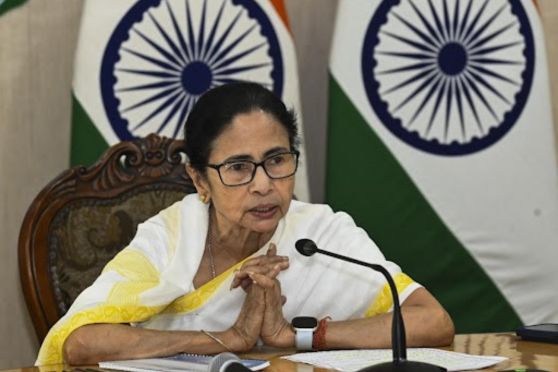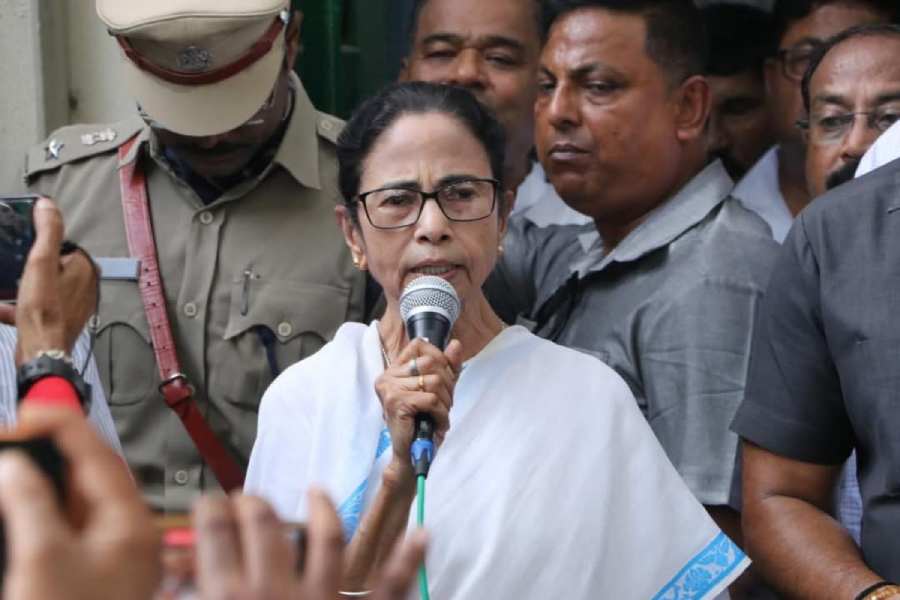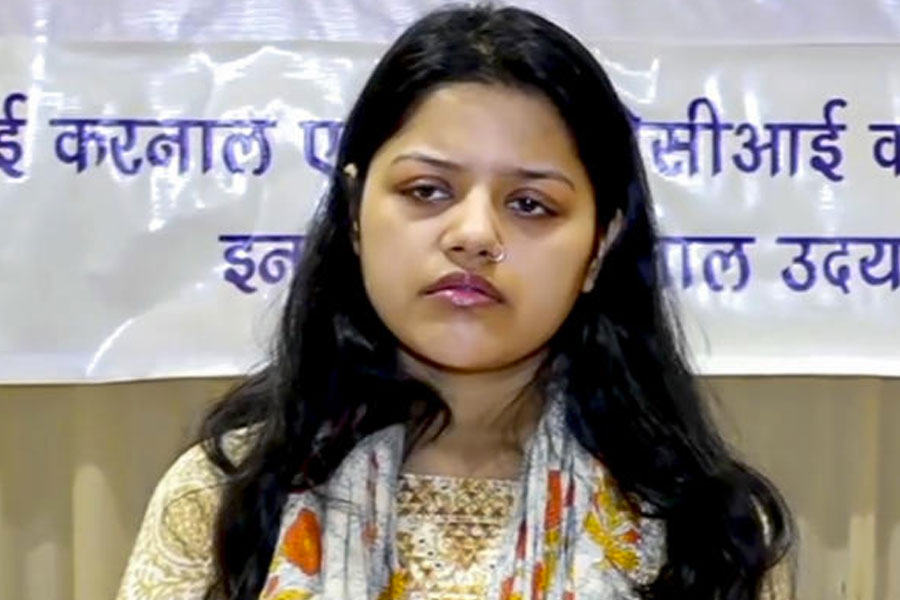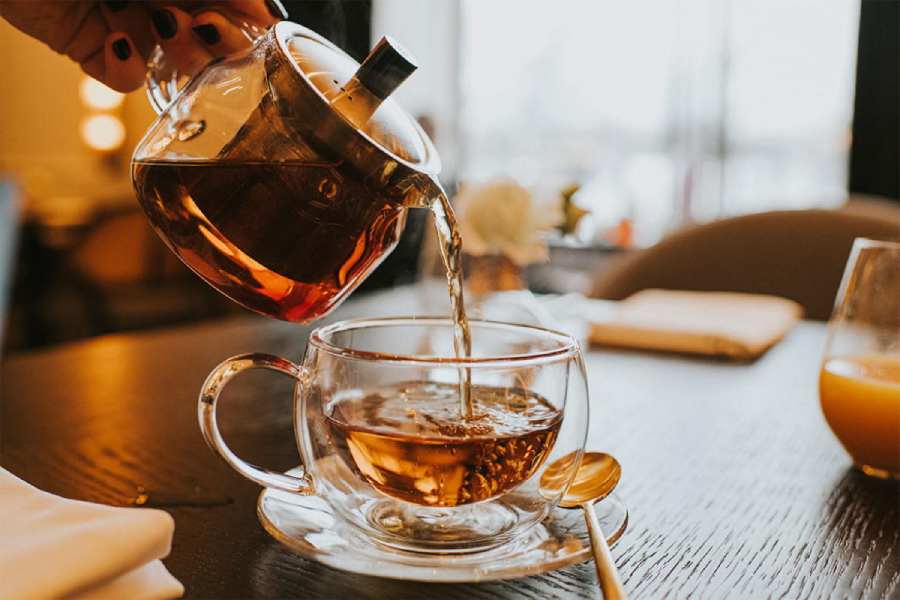 |
The term bindi is derived from the Sanskrit word bindu, meaning a dot. It is believed to act as a third eye and protect a woman (and her husband, as it was traditionally worn by married women) from evil. That belief, obviously, is passe. For if the bindi started off as a married woman’s mark, as a symbol of domesticity, of motherhood, of what was proper in a woman, of Nirupa Roy, it has now been liberated to be a symbol of sensuousness, individuality or fashion consciousness.
“Look what Sabyasachi Mukherjee has done with the red bindi!” points out fashion photographer Indranil Mukherjee. Sabya teams his clothes with the humble red bindi on the ramp.
Cut to another Calcutta landmark. For Usha Uthup, the singer who will not be seen without her gigantic round K-bindi, it all began in spirituality. “My mother used to say that one must take out some time and put on the bindi. As you dip your finger into the kumkum container and touch it to your forehead and remember God, you connect with your inner self,” she says. Uthup began to experiment when she was studying at JJ College of Arts, Mumbai. “I used to paint designs using watercolours. I have also used Camlin Crylin, the fabric colour that does not get smudged,” recalls Usha. So, what’s the story behind the famous ‘K’ inscribed bindi? “I decided to do something different, since I wear my love for the city on my heart and head. I started painting ‘K’ on my forehead. It caught on,” she laughs.
 |
 |
 |
 |
 |
Rekha & rest
But no woman has done more to upgrade the bindi than Rekha. The actress, the sexiest leading lady of 80s Bollywood, brought the round, maroon bindi into sharp focus.
Rekha, in films like Silsila, Agar Tum Na Hote or Zameen Asmaan, invented a style — her tall, elegant frame draped in a chiffon or a traditional cotton sari, paired with a demure blouse with half-sleeves (on occasions it could be a halter-neck), exaggerated eyelashes that somehow looked right, exaggerated maroon glossy lips, and everything topped with the round, moon-size maroon bindi. Rekha made the behenji over and made her hot. From under the sexy bindi, Rekha stared tantalisingly with her large, mascara-ed eyes from billboards, from film magazines, an 80s icon.
Says beautician and t2 columnist Priscilla Corner: “Rekha made bindis contemporary and fashionable. Earlier the round bindi in red and maroons were worn by the simple demure homemaker. Rekha turned it into a style statement.”
Dimple Kapadia took over from Rekha. She appeared with intricate, hand-painted black designs on her forehead in the late 80s and early 90s. By the mid-90s the round teep was replaced by long black bindis generally painted on with eyeliner. Though the liner bindi didn’t die out, Neena Gupta’s dot in the 1999 television serial Saans made the round bindi trendy again. The Saans look, with smoky eye make-up, hair in a neat bun and a round red bindi with a black line drawn below, became a rage. “If one has a big forehead or a broad face, the big red bindi is a perfect accessory. Which is why it suits Neena Gupta and Rekha so well,” says designer Ayan Sarkar.
After Saans the bevy of K-serial vamps brought another trend. Ramola Sikand (played by Sudha Chandran) and Komolika (played by Urvashi Dholakia) started the prevailing trend of literally OTT bindis that stretched from the hairline to the bridge of the nose. They were scary. “I think it looks ghastly and defeats the entire point of wearing the bindi. Any wedding you go to, you are bound to see women who would look attractive otherwise, spoiling it with their Ramola Sikand bindi,” says Anindya Ray, advertising professional, 23, with a passion for photography.
The boys
Not Ramola Sikand alone. Other bindis, too, like certain kinds of women, can seem frightening to men, who have had a lot to say on the bindi. “Big red bindis scare me. They almost make women look like the Cyclops,” grins 22-year-old MA student Aditya Ghosh. For many, small bindis read likeable and demure and big bindis mean intimidating.
But not even Ramola has been able to spoil the romance and erotic appeal of bindis. Boys like to see their women in bindis. “I would like my girlfriend to wear bindis of different colours. I think most Indian men would like to see their girlfriends or wives in bindis and saris, rather than in revealing outfits,” says Sudipto Karmakar, a 23-year-old economics student. There goes the conservative Indian male. For Anindya, a bindi is sensuous. “There is nothing more attractive than a discreet bindi between the brows, over a pair of kohl-lined eyes. Technically speaking, it adds colour and helps fill up space while taking photographs.”
Those who thought slipping into your mother’s red and white sari would make you look pure, think again, for it may not arouse holy emotions. Says 24-year-old MBA student Sourav Roy: “There is nothing sexier than a red bindi with a red-bordered white sari. The bindi looks idiotic with jeans. And the bizarre evolution of the bindi into snakes and pigeons is scary.”
The poets
And a lot of sensitive men — including poets — have fallen prey to the bindi. Tagore was one of them. “The Rabindrasangeet Bhalobeshe shokhi says Amar smaran shubho sindure ekti bindu enko tomar lalato chandane. It’s such a poetic way of describing the rather intimate act of putting on a bindi,” smiles 45-year-old homemaker Sushmita Bandyopadhyay. The lover is asking his beloved to think of him as she adorns her forehead with a vermilion dot.
Another Tagore poem Bhrashta Lagna, too, refers to the bindi. The lines “Godhuli belaye tokhono jalini deep, porite chhilam kopale shonar teep” describe a woman’s beauty ritual as dusk approaches.
Satyajit Ray’s Ghare Baire, too, has a poignant scene that uses the bindi effectively. Bimala’s bindi is seen fading and eventually disappearing, as a veiled reference to her husband Nikhilesh’s death. “Smudging the dot or the bindi has been used as a metaphor to portray widowhood or loss of honour for quite some time. Especially since colour came to Indian cinema,” says Moinak Biswas, head of the department, film studies, Jadavpur University.
Most lyricists of Bollywood, though, would have us believe that the words, bindiya and nindiya (or the lack of it, caused by the aforementioned bindiya) must come in pairs! Think of a young Amitabh singing Teri bindiya re to a blushing Jaya in Abhimaan. The Lamhe number has Sridevi lip-syncing Meri bindiya, mera kangna to claim how her adornments and jewellery can, again, steal the hero’s nindiya.
Sexist still?
Meanwhile, the bindi goes on adding beauty to daily lives. “As a dancer, the bindi is very important for me. The chitra, consisting of the teep and sandalwood patterns that is painted on the forehead, makes the eyes expressive,” says danseuse Sharmila Biswas.
Agnimitra Paul’s earliest memory of the bindi is that of her mother sticking her teep on the mirror before going in for a bath. “Patches used to be formed on the mirror. Then there was an aunt who was very fair and a small black bindi used to light up her face,” says the fashion designer, who, a perpetual backbencher in her MBA classes, used to sketch away different kinds of bindi designs.
While 26-year-old HR professional Shalini Roy feels that there is nothing like a sari and a bindi to make her feel like a woman, content-writer Pallavi Banerjee laughs about her mother-in-law asking her to wear a teep. “That, she says, will make me look komoniyo (soft).”
But there are also those women who will not buy the bindi argument. “I hate bindis. They cut my forehead. And you look more sophisticated without one. Femininity has nothing do with bindis. If a tomboy wears a bindi she will still look like a tomboy. I, however, have nothing against those who have chosen to create a certain look for themselves,” says the leggy model Nayanika Chatterjee.
Some feel that it has still retained its sexist hangover. “I don’t wear it. Why should only women wear it?” asks Bula Bhadra, professor and head, department of sociology, Calcutta University. “No one knows how the bindi originated. I think it came after the 6th century. Why does it always have to be a lal par sada sari with a big red bindi? Why not a sari with a black border and a black bindi? It is a kind of subtle sexism and coercion. I don’t, however, have a problem if people wear it as an ornament. What Usha Uthup wears is, after all, not imposed on her,” she adds.










